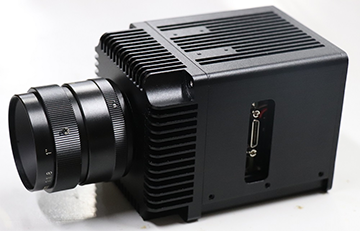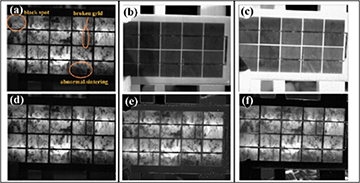
A new technique developed by researchers in China uses a high-frame-rate InGaAs detector, along with current modulation and a computer algorithm, to allow detection of solar-panel defects in broad daylight. [Image: Yunsheng Qian, Nanjing University of Science and Technology]
Solar energy is considered a key technology in the effort to reduce the burning of fossil fuels and stem climate change. But silicon solar panels—which account for more than 90% of all solar panels produced—can suffer from defects created in production and handling that can lower their overall efficiency. And unfortunately, current methods for defect detection usually require that it take place in the dark.
Now, researchers in China have developed a new method to detect defects in silicon solar panels—a method that’s effective even under bright sunlight (Appl. Opt., doi: 10.1364/AO.435456). That could enable repair crews to operate regardless of the time of day, to help keep the panels producing at their maximum capability. “We hope that this system can be used to help inspectors at photovoltaic power stations locate defects and identify them more quickly,” said Yunsheng Qian, who led the research team, in a press release accompanying the paper.
Wait until dark
The solar-panel defect-detection methods now in use rely on electroluminescence, photoluminescence and infrared thermal imaging. Electroluminescence, which is simple and intuitive, has become the most popular detection method.
However, the electroluminescence-based detection methods currently on the market have one huge drawback: They cannot detect defects under sunlight. That’s because the relevant electroluminescence wavelengths from a panel under inspection will be swamped by light of similar wavelengths in the sunlight. Therefore, solar-panel maintenance crews must work in darkness, either at night or in a dimly lit indoor space.
Blinking lights expose defects
To overcome this, researchers at Nanjing University of Science and Technology, China, have developed a method that combines new approaches in both hardware and software. The method starts by modulating the current source of solar panels that gives rise to the electroluminescence, which causes the electroluminescence signal from the panels to flicker.
Top: Images showing solar-panel defects, measured using traditional defect-detection methods, under low (left), medium (center) and high (right) sunlight irradiance. Bottom: The same solar panels, tested using the Nanjing University team’s newly developed method. [Image: Yunsheng Qian, Nanjing University of Science and Technology] [Enlarge image]
The flickering signal is then captured as an image sequence using an InGaAs detector with a high frame rate—with a band-pass filter placed in front of the detector to help block a portion of the unwanted sunlight. The detector the team used, with a quantum efficiency of 70% or higher, was able to fully capture an electroluminescence image sequence from silicon solar panels.
Next, the researchers process that image sequence using an algorithm they’ve developed that can distinguish blinking from nonblinking areas of the panel. After the algorithm identifies contrasting areas, it enhances the difference—which allows the researchers to pinpoint the defective spots.
When the researchers tested their method on polycrystalline silicon solar panels with multiple defects under the sunlight ranging from 0.2 to 1300 W/m2—corresponding to the difference in irradiance from night to noon—the method was able to pick out more than 90% of the defects.
Less time, less money
Previously, having to wait until dark to pick up defects increased not only time and labor costs, but also the probability of causing further damage to the solar panels. That suggests that the new method could reduce the overall time, money and effort that go into solar panel maintenance.
At the same time, the researchers hope that combining artificial intelligence with their method could further streamline the defect-detection process. In the meantime, they are working to improve the quality of the images by reducing digital noise.

